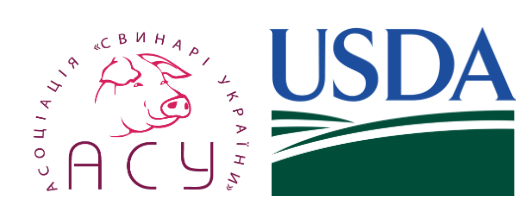
Why was the focus of cooperation with the USDA on the issue of pig health?
— Even before the war, the issue of epizootic well-being was one of the main issues for animal husbandry. After all, it directly affects their investment attractiveness, the ability to export products and, in general, carry out production activities.
A full-scale war could not but affect the control of the epizootic situation in pig breeding. The AUPB undertook to assess and minimize new risks with the U.S. Department of Agriculture through the technical support project Animal Health in Ukraine. USDA has been one of the main partners of the association since 2014. Given the new reality in which Ukraine found itself due to the invasion of the Russian Federation, it announced the possibility of receiving financial assistance to support domestic pig breeding. The concept of the ACS passed the competitive selection and received the "green light for implementation". It consisted of five components:
a large-scale industry survey to find out the impact of the war on pig farming in the industrial and homestead sectors, market players' awareness of African swine fever (ASF) and antibiotic resistance, as well as the level of biosecurity of pig farms and households;
free comprehensive laboratory diagnostics for enterprises in the de-occupied and territories close to hostilities;
an online school for veterinary medicine specialists in the field of pig production in partnership with Iowa State University;
biosafety audits of pig farms and preparation of videos on best biosafety practices;
development of the "Standard Operating Procedure for the actions of veterinary inspectors and employees of veterinary and sanitary examination laboratories in the market when signs of notifiable animal diseases are detected" and organization of simulation exercises in five regions of Ukraine for its practical application.
— Who was interviewed as part of the industry study and what consequences of the war did the respondents claim?
In total, 550 respondents were interviewed, including specialists from industrial pig farms, meat processing plants and hunting grounds; owners of households raising pigs; pork procurers who sell meat of slaughtered animals in agri-food markets; heads of the main regional departments of the State Service of Ukraine on Food Safety and Consumer Protection and state laboratories.
A survey on the impact of the war on pork production showed a decrease in livestock in 30% of households (out of 305 sample participants). 8% of commercial farms out of a hundred respondents reported direct material losses, a larger share — 13% — reduced the number of pigs from 3.5% to almost 97% after the start of the war, another 13% reported economic consequences due to the invasion of the russian federation.
65% of the twenty surveyed processing enterprises were not directly affected by the war: there was no damage to facilities or transport as a result of hostilities. 35% of the sample noted economic consequences, primarily difficulties with the delivery of pigs for slaughter and the sale of meat in the first months of the war.
— Were the results of the biosafety survey expected?
The survey confirmed the thesis of low levels in households, from the purchase of the animal (in illegal markets, without any health information) to the improper disposal of dead pigs and by-products of slaughter.
The total sample of industrial farms demonstrated a predominantly sufficient level of biosecurity. However:
60% of farms allow staff to bring personal belongings through the sanitary inspection room (mobile phones, cigarettes, underwear, hygiene products), i.e. the dirty and clean areas are not properly demarcated;
about half of the respondents allow incoming materials into production facilities without disinfection;
about a quarter of respondents do not prohibit staff from raising pigs at home;
less than 20% of those surveyed feed heat-treated feed to pigs of all age groups, despite the fact that unprocessed feed is a high risk factor associated with ASF;
14% of respondents allow staff to bring home-cooked food;
13% of farms allow staff/visitors to enter the territory without going through a sanitary inspection room and changing into work clothes provided by the farm;
10% of respondents allow new animals into the herd without laboratory diagnostics of diseases.
The results of the survey of procurers were also not unexpected and confirmed that this link in the pork chain carries the greatest risks of spreading diseases. Animals are purchased both from farms and households within a radius of up to 300 km, which can cover up to four regions. At the same time, only 7% of the 28 surveyed procurers said that they disinfect transport (none of them could name the name of the means used!). Moreover, about a third feeds the products of backyard slaughter to the farm animals they keep.
I wonder what the results of the African Swine Fever Awareness Survey turned out to be...
200 out of 305 surveyed households (65.6%) do not know about ASF. Half of them said it was the first time they had heard of such a disease. On the other hand, almost two-thirds of the industrial farms surveyed believe that ASF is a key risk for industrial herds. At the same time, only 5% of respondents correctly chose the clinical signs of this disease. Based on the respondents' assumptions, the key risk factors for ASF are:
- People (staff and owners of pig-raising households) (42%);
- Vehicles (29%);
- Gaps in farm biosecurity (19%);
- Feed (17%);
- Pigs (including wild pigs) and pork products (9%);
- Rodents and birds (4%);
- Insufficient state veterinary control (2%).
Every fifth respondent among processors said that they refuse to buy pigs from the farm because of unofficial information about the ASF outbreak. 35% of respondents blame the spread of ASF: 1) imperfect protocols for the elimination of ASF outbreaks; (b) pig dealers who buy pigs in infected areas and sell infected meat in agri-food markets; 3) pig owners (households and farmers) who do not report ASF to the relevant authorities and sell sick pigs or improperly dispose of dead animals.
— It seems that in this context, biosafety audits are in high demand?
— The biosecurity of the economy is never perfect, there is always something to improve. Therefore, audits are really in great demand, especially among enterprises from regions where ASF is more often registered. This work is systematic and began in 2014. What new and useful things were done within the framework of the project — together with enterprises that have the best biosafety protocols, we prepared training videos so that others could implement them on their farms. We focused on the aspects Which most often raise questions:
- admission of personnel and visitors to the production premises (passing the sanitary inspection room);
- disinfection of transport;
- disinfection of incoming materials;
- organization of a reloading ramp for animals;
- organization of a demarcation zone for transshipment of feed.
All videos are constantly available on the web resources of the AUPB.
Was the vet school popular with pig farm specialists? For what purpose was it organized and what topics did the program cover?
Starting from 2022, when grain prices fell significantly, and the price of livestock products, on the contrary, increased, non-core producers who had been engaged in crop production from time immemorial, decided to start raising pigs. In this way, they tried to make more profit by "converting" cheap grain into more expensive meat. A new segment of manufacturers has emerged in the industry. It is clear that it is quite difficult to re-profile, and even more so to engage in pig breeding in such a way as to organize high-quality veterinary support. Therefore, the idea arose in the ACS to create a veterinary school so that its participants received comprehensive knowledge about the health of pigs. The course consisted of five modules, during which a researcher and practicing veterinarian at Iowa State University, Dr. Justin Brown, domestic and international experts taught how to develop vaccination protocols and monitor the health of the herd, acclimatization of newly acquired young animals, considered different types of pig diseases and common diseases depending on the stage of animal rearing (diseases of sows, lactating piglets, pigs in rearing and fattening), principles of disinfection, etc. In each module of the school, the issues of laboratory diagnostics were studied in a separate block. They were taught by Dr. Dmytro Masyuk, Doctor of Veterinary Sciences, Professor, Director of the Research Center for Biosafety and Environmental Control of Resources of the Agro-Industrial Complex "Biosafety-Center".
The number of participants in the modules ranged from 50 to 100 specialists. We received a lot of positive feedback. The test participants especially liked the opportunity to communicate directly with the speakers.
Lectures of the course are available on the web resources of the ACS. You can take a course with testing on the AgroAcademy platform.
Ms. Oksana, you mentioned that one of the directions of the project was free laboratory support for enterprises located in the territories most affected by the war. How many farms have received such support?
Twenty enterprises, mainly from Mykolaiv, Dnipropetrovsk, Kharkiv, Zaporizhzhia, and Chernihiv regions. Some participants shared that thanks to comprehensive laboratory diagnostics, it was possible to find out the cause that negatively affected the results of activities, and thus improve the production performance of pigs.
In my opinion, this is an indicator that such support was necessary and useful for business.
— What conclusions can you draw about the effectiveness of this project? Will there be a sequel?
When we were planning the concept of the project, we did not chase the idea of "grant for grant's sake", but really focused on what the industry needs. All of the planned measures were implemented, despite the difficult situation in the country. Both the AUPB and the USDA have a desire to continue the program. The concept of the second stage has already been approved, implementation will begin in January 2024. More enterprises will have the opportunity to provide free laboratory diagnostics, this time including monitoring of feed raw materials for the presence of mycotoxins. A new service is veterinary support of pig farms. We will continue to work on improving biosecurity. Manufacturers will receive new trainings, including on the rational use of antimicrobials. It is also planned to work in cooperation with specialists of the State Service of Ukraine on Food Safety and Consumer Protection in order to improve the regulatory framework and conduct training for its specialists. The work plan is rich, the team of experts has been formed! I hope that at the end of 2024 there will be something to brag about again!
The Association of Ukrainian Pig Breeders is a non-profit, voluntary organization founded by Ukrainian pork producers. The main purposes of the association are representation and protection of rights and interests of farms of the association, assistance in development and introduction of new technologies for efficient production of pork, expansion of sales markets, and protection of domestic sales market.



